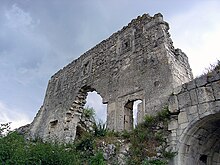
The Goths were Germanic people who played a major role in the fall of the Western Roman Empire and the emergence of medieval Europe.

The Ostrogoths were a Roman-era Germanic people. In the 5th century, they followed the Visigoths in creating one of the two great Gothic kingdoms within the Western Roman Empire, drawing upon the large Gothic populations who had settled in the Balkans in the 4th century. While the Visigoths had formed under the leadership of Alaric I, the new Ostrogothic political entity which came to rule Italy was formed in the Balkans under Theodoric the Great.
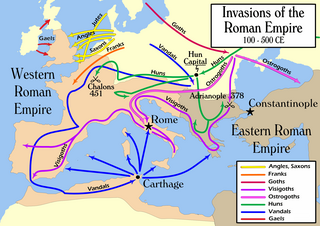
The Migration Period, also known as the Barbarian Invasions, was a period in European history marked by large-scale migrations that saw the fall of the Western Roman Empire and subsequent settlement of its former territories by various tribes, and the establishment of the post-Roman kingdoms.

The Gepids were an East Germanic tribe who lived in the area of modern Romania, Hungary and Serbia, roughly between the Tisza, Sava and Carpathian Mountains. They were said to share the religion and language of the Goths and Vandals.
Crimean Gothic was a Germanic, probably East Germanic, language spoken by the Crimean Goths in some isolated locations in Crimea until the late 18th century. Crimea was inhabited by the Goths in Late Antiquity and the Gothic language is known to have been in written use there until at least the mid 9th century CE. However, the exact relation of Crimean Gothic and “Biblical Gothic” is disputed.

The Sciri, or Scirians, were a Germanic people. They are believed to have spoken an East Germanic language. Their name probably means "the pure ones".

Ogier Ghiselin de Busbecq, sometimes Augier Ghislain de Busbecq, was a 16th-century Flemish writer, herbalist and diplomat in the employ of three generations of Austrian monarchs. He served as ambassador to the Ottoman Empire in Constantinople and in 1581 published a book about his time there, Itinera Constantinopolitanum et Amasianum, re-published in 1595 under the title of Turcicae epistolae or Turkish Letters. His letters also contain the only surviving word list of Crimean Gothic, a Germanic dialect spoken at the time in some isolated regions of Crimea. He is credited with the introduction of tulips into Western Europe and to the origin of their name.

Mangup also known as Mangup Kale is a historic fortress in Crimea, located on a plateau about 13 kilometres east of Sevastopol.
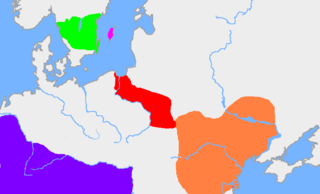
Oium was a name for Scythia, or a fertile part of it, roughly in modern Ukraine, where the Goths, under a legendary King Filimer, settled after leaving Gothiscandza, according to the Getica by Jordanes, written around 551.

The Principality of Theodoro, also known as Gothia (Γοτθία) or the Principality of Theodoro-Mangup, was a Greek principality in the southern part of Crimea, specifically on the foothills of the Crimean Mountains. It represented one of the final rump states of the Eastern Roman Empire and the last territorial vestige of the Crimean Goths until its conquest by the Ottoman Empire by the Ottoman Serb Gedik Ahmed Pasha in 1475. Its capital was Doros, also sometimes called Theodoro and now known as Mangup. The state was closely allied with the Empire of Trebizond.
The Goths, Gepids, Vandals, and Burgundians were East Germanic groups who appear in Roman records in late antiquity. At times these groups warred against or allied with the Roman Empire, the Huns, and various Germanic tribes.

The Greuthungi were a Gothic people who lived on the Pontic steppe between the Dniester and Don rivers in what is now Ukraine, in the 3rd and the 4th centuries. They had close contacts with the Tervingi, another Gothic people, who lived west of the Dniester River. To the east of the Greuthungi, living near the Don river, were the Alans.
Michael Kulikowski is an American historian. He is a professor of history and classics and the head of the history department at Pennsylvania State University. Kulikowski specializes in the history of the western Mediterranean world of late antiquity. He is sometimes associated with the Toronto School of History and was a student of Walter Goffart.

Herwig Wolfram is an Austrian historian who is Professor Emeritus of Medieval History and Auxiliary Sciences of History at the University of Vienna and the former Director of the Institute of Austrian Historical Research. He is a leading member of the Vienna School of History, and internationally known for his authoritative works on the history of Austria, the Goths, and relationships between the Germanic peoples and the Roman Empire.
The Metropolitanate of Gothia, also known as the Eparchy of Gothia or Metropolitanate of Doros, was a metropolitan diocese of the Patriarchate of Constantinople in the Middle Ages.
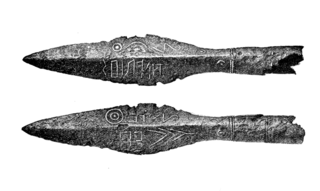
Gothic paganism was the original religion of the Goths before their conversion to Christianity.
Cannabaudes or Cannabas was a third-century leader of the Gothic tribe of the Tervings, who died in a battle against the Roman emperor Aurelian.
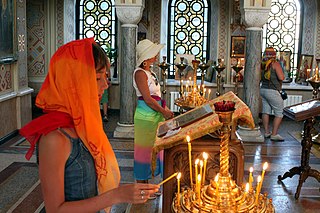
The majority of the Crimean population adheres to the Russian Orthodox Church, with the Crimean Tatars forming a Sunni Muslim minority, besides smaller Roman Catholic, Ukrainian Greek Catholic, Armenian Apostolic and Jewish minorities.

The name of the Goths is one of the most discussed topics in Germanic philology. It is first recorded by Greco-Roman writers in the 3rd century AD, although names that are probably related appear earlier. Derived from Proto-Germanic *Gutōz ~ *Gutaniz, it is closely related to and probably means the same as the names of both the Geats of southern Sweden and Gutes of Gotland. The implications of these similarities, and the actual meaning of the Gothic name, are disputed in scholarship.
Concerning the origin of the Goths before the 3rd century, there is no consensus among scholars. It was in the 3rd century that the Goths began to be described by Roman writers as an increasingly important people north of the lower Danube and Black Sea, in the area of modern Romania, Republic of Moldova, and Ukraine. They replaced other peoples who had been dominant in the region, such as especially the Carpi. However, while some scholars, such as Michael Kulikowski, believe there is insufficient evidence to come to strong conclusions about their earlier origins, the most commonly accepted proposal is that the Goths known to the Romans were a people whose traditions derived to some extent from the Gutones who lived near the delta of the Vistula in what is now Poland. More speculatively, the Gutones may have been culturally related to the similarly named Gutes of Gotland and the Geats of southern Scandinavia.

